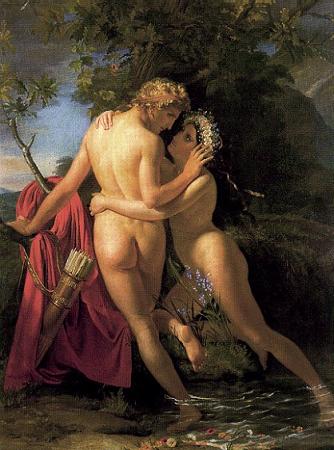Hermaphroditus. In Greek mythology, Hermaphroditus or Hermaphroditos was the son of Aphrodite and Hermes. According to Ovid, he was born a remarkably handsome boy with whom the naiad Salmacis fell in love and prayed to be united forever. A god, in answer to her prayer, merged their two forms into one and transformed them into an androgynous form. His name is compounded of his parents' names, Hermes and Aphrodite. He was one of the Erotes. Because Hermaphroditus was a son of Hermes, and consequently a great-grandson of Atlas, sometimes he is called Atlantiades. Hermaphroditus' father, Hermes, was also called Atlantiades because his mother, Maia was the daughter of Atlas. Hermaphroditus' name is the basis for the word hermaphrodite. Hermaphroditus, the two-sexed child of Aphrodite and Hermes had long been a symbol of androgyny or effeminacy, and was portrayed in Greco-Roman art as a female figure with male genitals. Theophrastus's account also suggests a link between Hermaphroditus and the institution of marriage. The reference to the fourth day of the month is telling: this is the luckiest day to have a wedding. Hermaphroditus's association with marriage seems to have been that, by embodying both masculine and feminine qualities, he symbolized the coming together of men and women in sacred union. Another factor linking Hermaphroditus to weddings was his parents' role in protecting and blessing brides. Hermaphroditus's name is derived from those of his parents Hermes and Aphrodite. All three of these gods figure largely among erotic and fertility figures, and all possess distinctly sexual overtones. Sometimes, Hermaphroditus is referred to as Aphroditus. The phallic god Priapus was the son of Hermes by some accounts and the youthful god of desire Eros of Ares and Aphrodite. Further information: Salmacis and Salmacis Ovid's account relates that Hermaphroditus was nursed by naiads in the caves of Mount Ida, a sacred mountain in Phrygia. At the age of fifteen, he grew bored with his surroundings and traveled to the cities of Lycia and Caria. It was in the woods of Caria, near Halicarnassus that he encountered the nymph, Salmacis, in her pool. She was overcome by lust for the boy, who was very handsome but still young, and tried to seduce him, but was rejected. When he thought her to be gone, Hermaphroditus undressed and entered the waters of the empty pool. Salmacis sprang out from behind a tree and jumped into the pool. She wrapped herself around the boy, forcibly kissing him and touching his breast. While he struggled, she called out to the gods that they should never part. Her wish was granted, and their bodies blended into one form, a creature of both sexes. Hermaphroditus prayed to Hermes and Aphrodite that anyone else who bathed in the pool would be similarly transformed, and his wish was granted. In this form the story was certainly not ancient, Karoly Kerenyi noted. He compared the myth of the beautiful ephebe with Narcissus and Hyacinthus, who had an archaic hero-cult, and Hymenaios. Diodorus Siculus in his work Library of History mention, that some say that Hermaphroditus is a god and appears at certain times among men, but there are some who declare that such creatures of two sexes are monstrosities, and coming rarely into the world as they do have the quality of presaging the future, sometimes for evil and sometimes for good. The oldest traces of the cult in Greek countries are found in Cyprus. Here, according to Macrobius, there was a bearded statue of a male Aphrodite, called Aphroditus by Aristophanes. Philochorus in his Atthis further identified this divinity, at whose sacrifices men and women exchanged garments, with the Moon. A terracotta plaque from the 7th century BC depicting Aphroditos was found in Perachora, which suggests it was an archaic Greek cult. The deification and the origins of the cult of hermaphrodite beings stem from Eastern religions, where the hermaphrodite nature expressed the idea of a primitive being that united both genders. This double sex also attributed to Dionysus and Priapus-the union in one being of the two principles of generation and conception-denotes extensive fertilizing and productive powers. This Cyprian Aphrodite is the same as the later Hermaphroditos, which simply means Aphroditos in the form of a herma, and first occurs in the Characters of Theophrastus. After its introduction at Athens, the importance of this deity seems to have declined. It appears no longer as the object of a special cult, but limited to the homage of certain sects, expressed by superstitious rites of obscure significance. We find in Alciphron that there was at Athens a temple of Hermaphroditus.
more...








